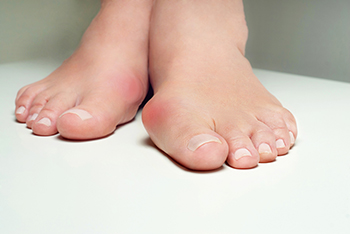Foot and Ankle Specialist
What to Do for Bunions
Tuesday, 26 April 2022 00:00
Bunions, also referred to as “hallux valgus” can become painful. A bunion is a bump on the side of the big toe that comes from an inherited structural problem with the foot or changes in the bones in the front part of the foot from wearing shoes that crowd the toes. When one develops a bunion, it means that the big toe starts leaning towards the second toe rather than pointing straight forward. Though symptoms such as pain, inflammation and redness, a burning sensation, and numbness can come in later stages of bunion development, sometimes there are never symptoms other than the bump. Dealing with a bunion may be as simple as changing shoes to ones that have more room in the toe box and don’t put the foot at an unnatural angle, such as when wearing high heels. Other ways of helping with a bunion include placing padding over the bump, spending less time on your feet, modifying activities, getting cortisone shots, or possibly having surgery. A visit to a podiatrist will confirm a diagnosis of a bunion and appropriate treatment will be suggested.
If you are suffering from bunions, contact Don A. Shumway, DPM of Arizona. Our doctor can provide the care you need to keep you pain-free and on your feet.
What Is a Bunion?
A bunion is formed of swollen tissue or an enlargement of boney growth, usually located at the base joint of the toe that connects to the foot. The swelling occurs due to the bones in the big toe shifting inward, which impacts the other toes of the foot. This causes the area around the base of the big toe to become inflamed and painful.
Why Do Bunions Form?
Genetics – Susceptibility to bunions are often hereditary
Stress on the feet – Poorly fitted and uncomfortable footwear that places stress on feet, such as heels, can worsen existing bunions
How Are Bunions Diagnosed?
Doctors often perform two tests – blood tests and x-rays – when trying to diagnose bunions, especially in the early stages of development. Blood tests help determine if the foot pain is being caused by something else, such as arthritis, while x-rays provide a clear picture of your bone structure to your doctor.
How Are Bunions Treated?
- Refrain from wearing heels or similar shoes that cause discomfort
- Select wider shoes that can provide more comfort and reduce pain
- Anti-inflammatory and pain management drugs
- Orthotics or foot inserts
- Surgery
If you have any questions, please feel free to contact our office located in Snowflake, AZ . We offer the newest diagnostic and treatment technologies for all your foot care needs.






